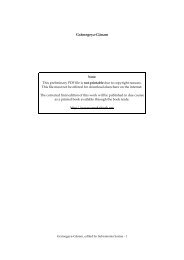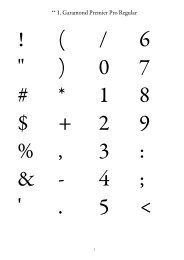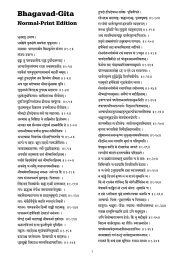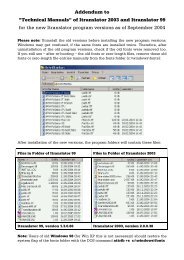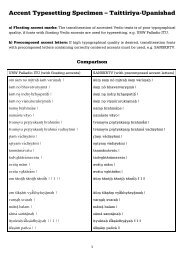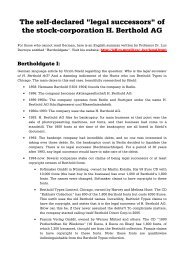[[1-1-1]] [[Book-Chapter-Paragraph]] - Sanskrit Web
[[1-1-1]] [[Book-Chapter-Paragraph]] - Sanskrit Web
[[1-1-1]] [[Book-Chapter-Paragraph]] - Sanskrit Web
Create successful ePaper yourself
Turn your PDF publications into a flip-book with our unique Google optimized e-Paper software.
and Vayu is connected with the Rathantara (Saman), the fifth day is connected with the Rathantara,<br />
and therefore on the fifth day [2] (the cup) for Indra and Vayu is drawn; verily he draws it in its<br />
own abode. The Çukra is connected with the Brhati, the sixth day is connected with the Brhati, and<br />
therefore on the sixth day the Çukra is drawn; verily he draws it in its own abode. In that it<br />
completes the metres, it completes for the second time the sacrifice; in that the Çukra is drawn on<br />
the next day, where they have seen the sacrifice, thence does he again employ it. The third three<br />
nights begin with the Tristubh, the Çukra is connected with the Tristubh [3]; in that the Çukra is<br />
drawn on its seventh day, he draws it in its own abode, and they revolve round their own metre. The<br />
Agrayana, is speech, the eighth day is speech, and therefore on the eighth day the Agrayana is<br />
drawn; verily he draws it in its own abode. (The cup) for Indra and Vayu is breath, the ninth day is<br />
breath, and therefore on the ninth day (the cup) for Indra and Vayu. is drawn; verily he draws it in<br />
its own abode. In that [4] it completes the metres, it completes for the third time the sacrifice; in that<br />
(the cup) for Indra and Vayu is drawn on the next day, where they have seen the sacrifice, thence<br />
does he again employ it, and they revolve round their own metre. They go by a trackless way<br />
leaving the path who start with anything except (the cup) for Indra and Vayu. The tenth day is the<br />
end of the sacrifice, (the cup) for Indra and Vayu is drawn on the tenth day; verily having reached<br />
the end of the sacrifice [5], they proceed from the trackless way to the path, and it is as when men<br />
go pushing on with a strong (team). The metres set their wishes on one another's world, and the<br />
gods then interchanged them. The fourth day is the abode of (the cup) for Indra and Vayu, the<br />
Agrayana is drawn on this (day); therefore (the cup) for Indra and Vayu is drawn on the ninth day,<br />
the abode of the Agrayana. The fifth day is the abode of the Çukra [6], (the cup) for Indra and Vayu<br />
is drawn on this (day); therefore the Çukra is drawn on the seventh day, the abode of (the cup) for<br />
Indra and Vayu. The sixth day is the abode of the Agrayana, the Çukra is drawn on this (day);<br />
therefore the Agrayana is drawn on the eighth day, the abode of the Çukra. Verily thus does he<br />
exchange the metres, and he who knows thus obtains interchange with the richer; verily also he<br />
causes concord in the sacrifice for the gods. Therefore one gives this to another.<br />
[[7-2-9]]<br />
Prajapati desired, 'May I be propagated.' He saw this (rite) of twelve nights; he grasped it, and<br />
sacrificed with it. Then indeed was he propagated. He who desires, 'May I be propagated', should<br />
sacrifice with (the rite) of twelve nights; verily he is propagated. The theologians say, 'The<br />
sacrifices have Agnistomas at the beginning; why then is Atiratra first employed?' The two Atiratras<br />
are the eyes of the sacrifice, the two Agnistomas the pupils; if [1] they were to employ the<br />
Agnistoma first, they would put the pupils outside; therefore the Atiratra is employed first; verily<br />
having inserted the eyes of the sacrifice they put the pupils in them. He, who knows the Gayatri to<br />
have sides of light, goes to the world of heaven with light and radiance. The sides are the<br />
Agnistomas, the eight Ukthyas in between are the body; verily the Gayatri has sides of light. He<br />
who knows thus goes to the world of heaven with light and radiance [2]. The twelve nights' (rite) is<br />
Prajapati in twelve divisions. The two sides are the Atiratras, the eight Ukthyas within are the body;<br />
Prajapati in such guise touches truth with the Sattra, truth is the breaths; verily he touches the<br />
breaths. Those who perform the Sattra perform it with the breath of all people, and therefore they<br />
ask, 'Are these performers of a Sattra?' Dear to people and noble is he who knows thus.<br />
[[7-2-10]]<br />
This (rite) with a Vaiçvanara on one side (only) was not able to win the world of heaven; it was<br />
stretched upwards and the gods piled round this Vaiçvanara, to overcome the world of heaven. The<br />
seasons made Prajapati sacrifice with it, and in them because of it he prospered. He prospers among<br />
the priests who knowing thus sacrifices with (the rite) of twelve days. They were desirous of<br />
obtaining (their desires) from him. He gave to the spring the sap [1], to the hot season barley, to the<br />
rains plants, to autumn rice, beans and sesamum to winter and the cool season. Prajapati made Indra<br />
sacrifice with it. Then indeed did Indra become Indra; therefore they say, 'It is the sacrifice of the<br />
inferior', for he by it first sacrificed. He eats a corpse who accepts a present at a Sattra; a human<br />
corpse or the corpse of a horse. Food is the cow; in that he does not purify the vessel in which they<br />
Keith: Taittiriya-Samhita, Translation - Page 313 of 341


![[[1-1-1]] [[Book-Chapter-Paragraph]] - Sanskrit Web](https://img.yumpu.com/25993632/313/500x640/1-1-1-book-chapter-paragraph-sanskrit-web.jpg)

